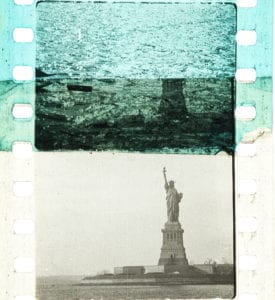It’s International Archives Day.
June 9, 1948: The United Nations Educational, Scientific, and Cultural Organization convened a meeting of archivists who created the International Council on Archives. In 2007, ICA declared the 9th of June as International Archives Day, an occasion to raise awareness of the importance of these memory institutions. Although sometimes perceived as dead-letter offices or institutions where the Ark of the Covenant gets forgotten, archives are, advocates contend, essential for a healthy society. An ICA declaration of 2010 ends with this: “Open access to archives enriches our knowledge of human society, promotes democracy, protects citizens’ rights and enhances the quality of life.” Democracy, no less! One might add liberty.
The excitement of discovery (more correctly, rediscovery) is a feeling that exploring past records sometimes evokes. Even more so when serendipity allows for moments of connection, of rhyme.
The image of the Statue of Liberty being submerged in a flood became a frontispiece for the 2020 Orphan Film Symposium on Water, Climate, and Migration. That the flood was said to be caused by melting polar ice caps, as presciently visualized in this 1929 newsreel outtake, makes its moving image presence uncanny. As the first film shown during Orphans Online, If the Antarctic Ice Cap Should Melt? created a sensation. With Stephen Horne‘s original music scoring it for the occasion, the film took yet another form. Recently scanned by the University of South Carolina Moving Image Research Collections from its Fox Movietone Newsreel archive, the tinted nitrate film’s high resolution remains a thing of beauty even in this online stream.

The rhyme came in the unexpected form of another silent film, also scored by Stephen Horne. The Deutsches Filminstitut and Filmmuseum‘s new scan of its tinted and toned nitrate compilation known as An Atlantic Voyage (ca. 190? – 191?) was the final screening of Orphans Online. But it was not until the eve of the final day that we knew for certain this reel of uncertain provenance would be programmed and that it would in fact be the finale. Not only was it an appropriate bon voyage sign-off, it too included a shot of Liberty Enlightening the World as seen from a vessel in New York Harbor, date uncertain.
Later this week, this site will repost a recording of the May 26 live-streamed opening session as well as the May 29 closing. USC MIRC curator Greg Wilsbacher reports on the archival elements that make up the 1929 Fox footage, while the three NYU students who did further research on it present their Antarctic findings. DFF archivist Anke Mebold introduces the Atlantic scenes.
Meanwhile, in celebration of International Archives Day, have a look at these two previously obscure films and listen to maestro Horne’s rendering them as a multi-instrumental suite. And thank the two archives that preserved these films and permit them to stream here for a generous but limited time.
Click to enlarge, or watch at vimeo.com/421741172.
Click to enlarge, or watch at vimeo.com/421716635 .
An Atlantic Voyage: Von Hamburg zu den Niagarafällen mit dem Schnelldampfer Kaiser Wilhelm II [From Hamburg to the Niagara Falls with the Express Steamer Kaiser Wilhelm II] (DE[?] 19?? / GB 1903[?] / FR 1906[?]); with footage from [?] Charles Urban Trading Company / Pathé Frères.
The video report stands alone.
P.S.
The Jiang, Lai, and Yang report includes a discussion of tinting and toning in silent newsreels.
As it happens, after posting this, I see that for the Timeline of Historical Film Colors, Barbara Flueckiger made 14 two-frame photographs of the DFF nitrate positive film print that was later scanned to make the moving image file seen above. — D.S.
See <filmcolors.org/galleries/an-atlantic-voyage>
